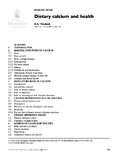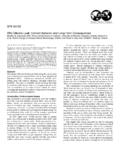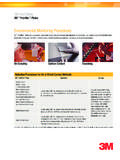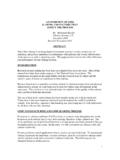Transcription of Great Ormond Street Hospital for Children
1 hydration in infants and childrenVanessa ShawGreat Ormond Street Hospital for ChildrenHomeostasis the key to adequate hydration Large variations in daily intake of water Tolerance due to body s homeostatic mechanisms Kidney adjusts absorption & excretion of water maintain plasma osmolality 275-290mOsm/kg plasma sodium 135-145mmol/l No need for exact precision in determining requirements for waterIn healthy Children :Getting the right balance Water in (+ve balance) Drinking Produced by body in oxidative metabolismWater out (-ve balance) Urine 60% Skin and lungs 35% Stool 5%Water balance maintained within (Grandjean et al, 2003)Fluid requirements Young infants ~150ml/kgToddler ~100ml/kgAdult ~50ml/kgWater depletion more likely in childrenWhy do infants and Children have higher fluid requirements?
2 CompositionLarger Total Body Water content Foetus >90% total body massTerm infant ~ 75% during 1styear of lifeRemains stable until pubertyAdult 60% males50% females Why do infants and Children have higher fluid requirements?2. Higher surface to mass ratio water losses through the skinMore susceptible to changes in temperature3. Higher respiratory & metabolic rate water lost via lungsDramatic growth in 1styear of life(3 x weight gain; 50% in length)Continuing growth to adolescenceWhy do infants and Children have higher fluid requirements?
3 4. Immature renal functionFoetusproduces urine from ~ 10th week of gestation At birthglomerular & tubular function deficientGlomerular Filtration Rate is low Impacts water & electrolyte homeostasis & excretion of waste productsLow concentrating capacity if water depleted the kidney still produces dilute urineImmature renal function(from Guignard & Drukker in Clinical Paediatric Nephrology, eds Webb & Postlethwaite, 2003)2 weeks 8 weeks1 yearMaximum urine osmolality(mOsm/kg H2O)700-8001000-12001200-1400 GFR(ml/ )35-4575-8090-110 Other risks for water depletion5.
4 Thirst sensitivityLearned behaviour dryness drinking 1-2% in plasma osmolality thirst reflexChildren don t display this thirst sensitivity long periods without drinking (Box & Landman,1994) may not drink enough after exercise (Bar-Or et al, 1980)Other risks for water depletion6. Body cooling mechanisms & heat tolerance sweat rates (Meyer et al, 1992) acclimatisation to heat (Falk & Dotan, 2008; Bytomski & Squire, 2003) risk when exercising (AAP, 2000)Lack of recognition of need to replace lost fluidsInfants & Children are at greater risk for dehydration because of their agePhysiological Body composition Higher surface to mass ratio Higher metabolic rate Immature renal function Less heat tolerant Decreased thirst sensitivityDevelopmental and social Dependency on caregiversDependency on care givers Infants & toddlers cannot ask for drinksMust be given regular fluidsRely on caregivers to pick up on cues hunger vs thirstLack of awareness of insensible water losses
5 Inadequate spontaneousintake Lack of thirst responseSigns of dehydrationOnly ~ parents can identify > 1 sign of dehydration (Gittelman et al, 2004)Degree of dehydrationInfantOlder childMild<5% infant<3% childThirsty, alert, restless, urineModerate5-10% infant3-6% childLethargic, drowsy, sunken eyed, urineAlert, postural dizziness, sunken eyed, urineSevere >10% infant>6% childLimp, cold, urine consciousnessApprehensive, cold, urine, crampsWater requirements for infants and Children Need for water highly individual & multifactorial.
6 Age, gender, body mass, environment, activityDifficult to define universal recommendation for populations European Food Safety Authority 2008* Institute of Medicine 2005** World Health Organization 2003, 2005**includes water from beverages and food **includes water from beverages,food and water absorbed during cookingBased on water intakes & urine osmolality, not hydration statusComparison of recommendations infantsAgemonthsEFSA 2008 Draft Dietary Reference ValuesInstitute of Medicine 2005 Adequate IntakesWHO 2003, 2005 Requirements0-4750 ml/d0-6 100-190 ml/kg/d700 ml/d6-12 800-1000ml/d7-12800 ml/d8-121000 ml/dFluid requirements for infantsYoung infant (0-6m)Fluid = nutrition Breast fedDemand breast feeding provides fluid & nutritional requirements 150ml/kg 100kcal/kg 130ml water/kgNo extra fluid neededFluid requirements for infantsYoung infant (0-6m)Fluid = nutrition Formula fed 150ml/kg 100kcal/kg 130ml water/kgMay require extra cooled boiled waterFluid requirements for infantsOlder infant (6-12m)
7 Fluid derived from weaning foods High water content: fruits & veg 90-95%6 month oldwt 7kg120ml/kg formula = 840ml = 80kcal/kg2 x 120g fruit/veg = 220ml = 20kcal/kgTotal fluid = 150ml/kgOnce weaning is established Foods have lower water content Rice & pasta 65-80%Fish 70-80%Meat 45-65%Bread 30-45% (Grandjean & Campbell, 2004) Water with meals (from a clean cup or beaker) Tap water or bottled water (NB Na < 200mg/l)Does not need to be boiledDo not need fruit juices or baby juices Comparison of recommendations childrenAge (y)
8 EFSA 2008 Draft DRVIoM 2005 Adequate IntakesWHO 2003, 2005 Requirements12-24 l/d1-3 l/d2-3 l/d9-13 (boys)9-13 (girls) l/d14-18 (boys)14-18 (girls) l/dHow much do Children actually drink?National Diet and Nutrition Survey 2008/09 Doesn t include fluid from foodFluid1 - 3 y4 - 10 y11 - 18 yMilk whole, skimmedsemi-skimmed, 278187141 Beveragesfruit juice, soft drinks, tea, coffee, water5276681025 Total8058551166 Are our Children chronically dehydrated?Age (y)NDNS2008/09 Recorded TotalEFSA 2008 IoM 2005 WHO 2003, 051 - 3805ml (+ 400ml) 1205ml1300ml1000ml4 - 8855ml(+ 500ml)1355ml1600ml1700ml14 18 boys1264ml (+ 600ml)1864ml3300ml14 18 girls1060ml (+ 500ml)
9 1560ml2300mlRisks of having too much waterNeonatecannot efficiently excrete water loadInfants and toddlers Small stomach volume Decreased appetite Inadequate energy and nutrients Faltering growthCase study1 year old girlAt birth weight, length on 25thcentileHC on 9thcentileAt 1 year dramatic faltering growthDiet history: fluid intake 190ml/kg1000ml water daily300ml formula = 30kcal/kg3 small meals = 35kcal/kg Energy intake = 65kcal/kg normal req = 95kcal/kg Risks of having too little waterExcessive milk drinking in toddlers Decreased appetite for foods Iron deficiency anaemia associated with milk intake > 500ml/d (Cowin et al, 2001.)
10 Gunnarsson et al, 2004) Increased saturated fat intakeCase study2 year old girlDrinking 1000ml full fat cows milk dailyEnergy req 1230kcal Iron req saturated fat = 11% total dietaryenergy1000ml milk= 650kcal= 24g SFA (18% energy)= ironRisks of having too little waterExcessive intake of high sugar drinks Obesity school Children given water consumption by glasses/day with risk of overweight of 31% (Muckelbauer et al, 2009) Poor appetite, poor weight gain, loose stools squash drinking syndrome - on reducing sugary drinks toddlers showed improvement in all symptoms (Hourihane & Rolles, 1995) Dental caries in young Children consuming regular soda pop, regular powdered beverages (& 100% fruit juice) had risk of caries (Marshall et al, 2003)A practical recommendation for fluid intake in healthy children6 8 drinks a day 100-120ml toddlers 160-180ml 5 yr old 200-220ml 10 yr old 280-300ml 15 yr oldSubject to.








